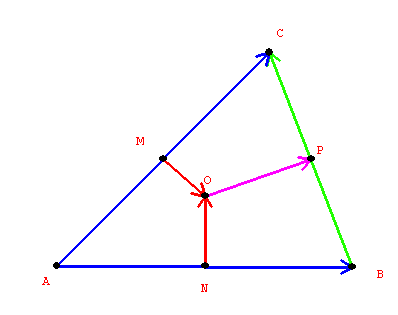-
-
Save mutoo/5617691 to your computer and use it in GitHub Desktop.
| function circumcircle(a, b, c) { | |
| this.a = a | |
| this.b = b | |
| this.c = c | |
| var A = b.x - a.x, | |
| B = b.y - a.y, | |
| C = c.x - a.x, | |
| D = c.y - a.y, | |
| E = A * (a.x + b.x) + B * (a.y + b.y), | |
| F = C * (a.x + c.x) + D * (a.y + c.y), | |
| G = 2 * (A * (c.y - b.y) - B * (c.x - b.x)), | |
| minx, miny, dx, dy | |
| /* If the points of the triangle are collinear, then just find the | |
| * extremes and use the midpoint as the center of the circumcircle. */ | |
| if(Math.abs(G) < 0.000001) { | |
| minx = Math.min(a.x, b.x, c.x) | |
| miny = Math.min(a.y, b.y, c.y) | |
| dx = (Math.max(a.x, b.x, c.x) - minx) * 0.5 | |
| dy = (Math.max(a.y, b.y, c.y) - miny) * 0.5 | |
| this.x = minx + dx | |
| this.y = miny + dy | |
| this.r = dx * dx + dy * dy | |
| } | |
| else { | |
| this.x = (D*E - B*F) / G | |
| this.y = (A*F - C*E) / G | |
| dx = this.x - a.x | |
| dy = this.y - a.y | |
| this.r = dx * dx + dy * dy | |
| } | |
| } |
This algorithm is faster (cf. my jsperf test case)
function circumcircle2(a, b, c) {
this.a = a;
this.b = b;
this.c = c;
var EPSILON = 1.0 / 1048576.0;
var ax = a.x,
ay = a.y,
bx = b.x,
by = b.y,
cx = c.x,
cy = c.y,
fabsy1y2 = Math.abs(ay - by),
fabsy2y3 = Math.abs(by - cy),
xc, yc, m1, m2, mx1, mx2, my1, my2, dx, dy;
/* Check for coincident points */
if(fabsy1y2 < EPSILON && fabsy2y3 < EPSILON)
throw new Error("Eek! Coincident points!");
if(fabsy1y2 < EPSILON) {
m2 = -((cx - bx) / (cy - by));
mx2 = (bx + cx) / 2.0;
my2 = (by + cy) / 2.0;
xc = (bx + ax) / 2.0;
yc = m2 * (xc - mx2) + my2;
}
else if(fabsy2y3 < EPSILON) {
m1 = -((bx - ax) / (by - ay));
mx1 = (ax + bx) / 2.0;
my1 = (ay + by) / 2.0;
xc = (cx + bx) / 2.0;
yc = m1 * (xc - mx1) + my1;
}
else {
m1 = -((bx - ax) / (by - ay));
m2 = -((cx - bx) / (cy - by));
mx1 = (ax + bx) / 2.0;
mx2 = (bx + cx) / 2.0;
my1 = (ay + by) / 2.0;
my2 = (by + cy) / 2.0;
xc = (m1 * mx1 - m2 * mx2 + my2 - my1) / (m1 - m2);
yc = (fabsy1y2 > fabsy2y3) ?
m1 * (xc - mx1) + my1 :
m2 * (xc - mx2) + my2;
}
dx = bx - xc;
dy = by - yc;
this.x = xc;
this.y = yc;
this.r = dx * dx + dy * dy;
}Both of these are incorrect as @jimarlow pointed out. It should be this.r = Math.sqrt(dx * dx + dy * dy);
@yahiko00
Checkmated

@louy @jimarlow Square root is "expensive" to compute. Having a squared distance is often enough.
Imagine you have a circle at (0,0) with a radius 5. Is the point (-4,4) inside that circle? You would probably test, if sqrt(16+16) < 5. Can you compute it without a calculator?
But actually, you can test, if 16+16 < 5*5, that is 32 < 25, which is not, so it is not in a circle. But it is in a circle of radius 6 (32<36).
Also, if the coordinates are integers, squared distances are also integers. You may not need to work with floats at all.
@louy @photopea Thank you guys, I don't even remember I ever wrote his.
I'd say it should be this, as it mentioned in the article:
this.rSq = dx * dx + dy * dy;
Since the reference page is gone, here is an archive link from the Wayback machine:
https://web.archive.org/web/20071030134248/http://www.exaflop.org/docs/cgafaq/cga1.html#Subject%201.01:%20How%20do%20I%20rotate%20a%202D%20point?
Depending on your circumstances you can do it with vectors. The intersection of at least two rays, each passing through the midpoint of a side of the triangle and perpendicular to that side, is the circumcenter. Proof seen here: https://flashman.neocities.org/Courses/Circumcenter.html
In this image below the (segments of) rays are M, N and P, each perpendicular to the side that they pass through the midpoint of:

The circumcenter is O, equidistant to the 3 vertices. In some cases it can be outside of the triangle.
There is an error:
this.r = dx * dx + dy * dy
should be
this.r =sqrt(dx * dx + dy * dy)